LG 29EA93 Ultrawide Display - Rev. 1.09
by Chris Heinonen on December 11, 2012 1:20 AM ESTLG 29EA93—Color Quality and Color Gamut
Out of the box, there is no sRGB mode for the LG 29EA93 to use, so I went with the Standard mode for the default testing. As always, I try to aim for a D65 white point, 2.2 gamma, and 200 nits of light output. All measurements are done using ColorEyes Display Pro, and using a NIST certified i1Pro spectrometer.
Just as expected, the 29EA93 is nothing to write home about straight out of the box. The dE average is just over 7, and the white error is very high as well. Without a pre-calibrated preset this is what I’d expect to see and so this isn’t really a surprise at all.
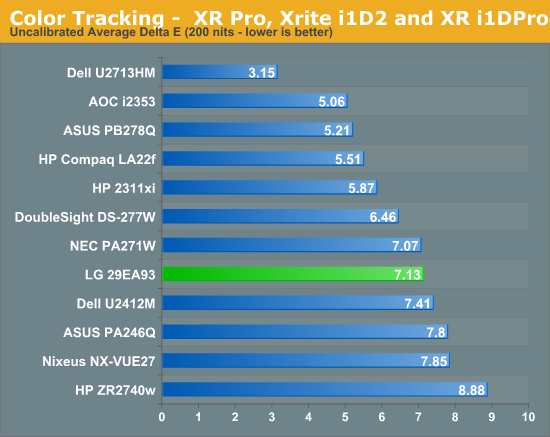
After a calibration, the LA 29EA93 fares much better. The average dE drops to a very respectable 1.61, and has a very low median dE of 1.33 as well. The main errors that are present are those that are hard for all displays to reproduce, such as certain blues, so this is a very nice calibrated result in the end for the LG.

When set to 100 nits that is more likely to be used for print media applications, the 29EA93 continues to have very nice calibrated results. The grayscale is nice and neutral, the colors are mostly accurate, and the resulting image is very nice on screen. Once calibrated the, LG 29EA93 produces an image that can keep up with the other IPS monitors out there.
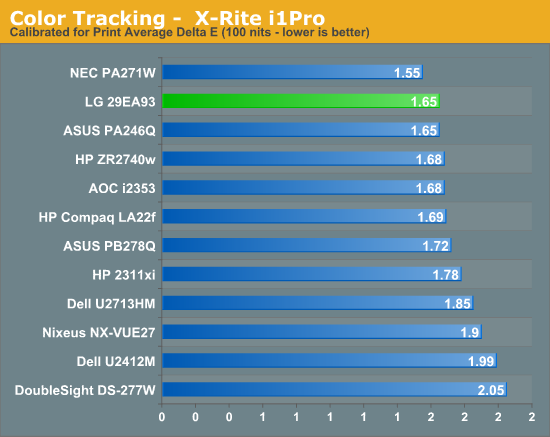
The one area that is does fall a bit short is in color gamut. It only covers 74% of the AdobeRGB gamut, which leaves it just a little short of the whole sRGB gamut. This little bit might not matter much in regular use, but it might matter more to those that are considering using it for color critical work.
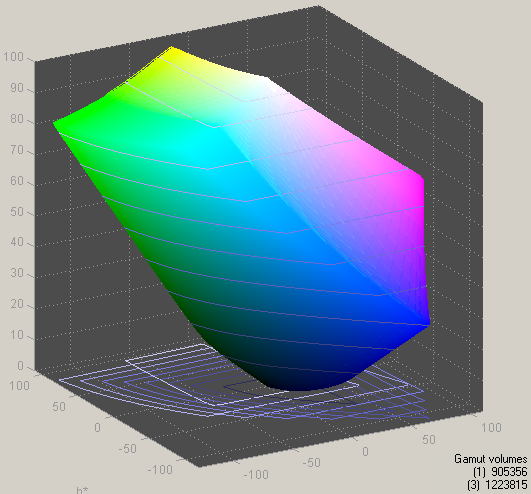
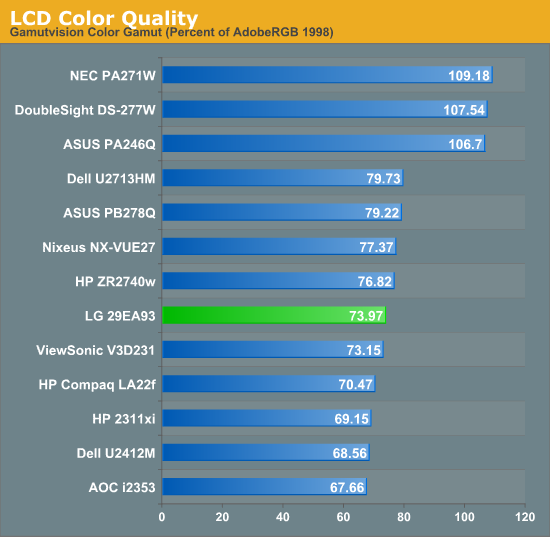


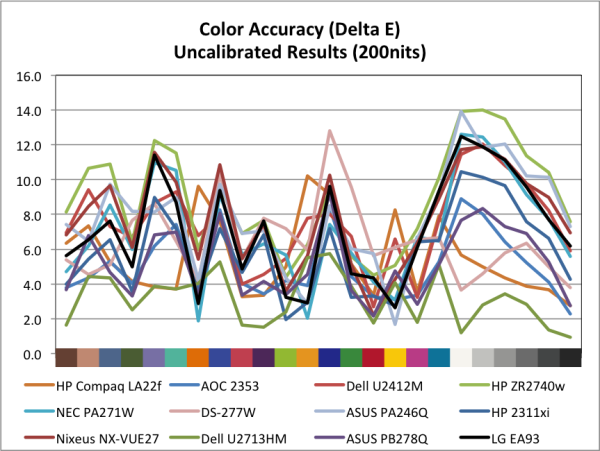
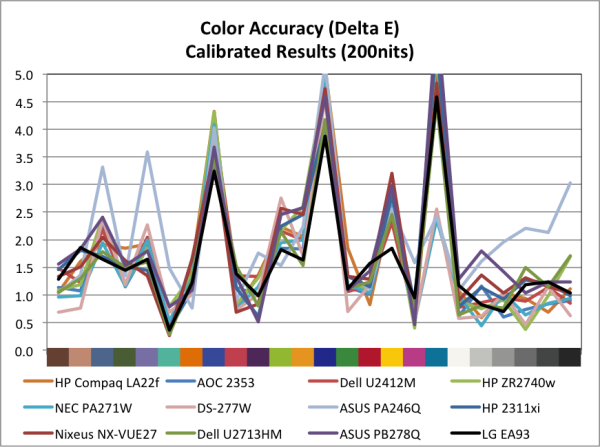
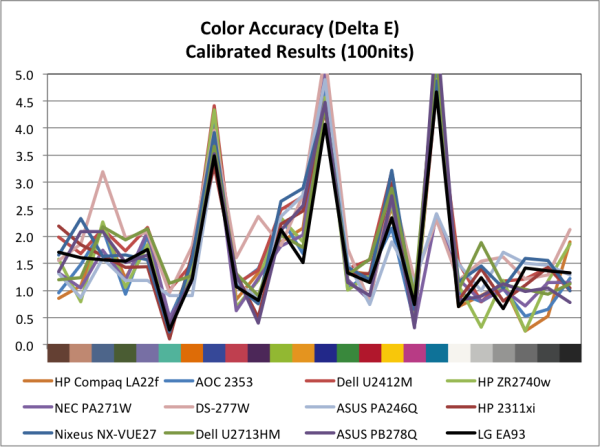








90 Comments
View All Comments
Rick83 - Tuesday, December 11, 2012 - link
Yes, if you come from 2 19" screens, you actually gain vertical pixels, instead of losing them, compared to a 27" screen.Also, who uses their 27" screen in portrait orientation? That line kind of struck me as a bit out-there. Even pivoting a 24 inch screen is laborious.
Blibbax - Tuesday, December 11, 2012 - link
It's common to have a landscape main monitor and a portrait secondary monitor. But yeah, I never actually pivot a monitor while using it.cheinonen - Tuesday, December 11, 2012 - link
I have a 27" monitor on an arm and I'll pivot it depending on what I'm working on. It's not common, but if I have a really tall spreadsheet or a document I'm working on, I like to have the ability, but I admit it's rare.Kevin G - Tuesday, December 11, 2012 - link
I have three 24" displays in portrait mode for Eyefinity. Works relatively well as the 3240 x 1920 is very close to a 16:9 aspect ratio. Bezel compensation alters this a bit so it is nearly a perfect 16:9 ratio.Using three of these 29" displays in portrait for Eyefinity would be roughly equivalent to a 4:3 aspect ratio from the days of old. Both old and new games support 4:3 aspect ratios so there would be some use.
The monitor itself is mainly the hassle for portrait mode. Not all of them have good stands that easily allow for portrait orientation, if at all.
ImSpartacus - Tuesday, December 11, 2012 - link
Check out this kickass PLP setup and you'll understand.http://www.youtube.com/watch?v=-AEAhExuaaM
ypsylon - Tuesday, December 11, 2012 - link
They should stop wasting doing monitors like that and create panoramic, concave 180 degree models to replace Eyefinity setups. I would much more prefer buying one big screen than wasting time (& cash) with buying 3 LCD and watching screen with borders of each LCD. I don't get it how people can live with stuff like that. Just brrr....Stop fooling around, bring bendy OLEDs now!
nathanddrews - Tuesday, December 11, 2012 - link
NEC did this just a couple years ago. AFAIK, it was a total flop (or just never made it to market).http://www.bhphotovideo.com/c/product/633263-REG/N...
Kevin G - Tuesday, December 11, 2012 - link
What's that basically two rear projection screen systems put into a single cabinet? I recall hear that that display as just physically big. Also the resolution wasn't as high as the typical Eyefinity setup.Neat concept though.
nathanddrews - Tuesday, December 11, 2012 - link
I'm pretty sure it came out before Eyefinity was announced, but I also know that it kept showing up at CES for a couple years before finally being available to the public. I believe it was two DLP projection units in one cabinet, but I think it was seen by the PC as one monitor. All I know is that people that saw it IRL said it was a thing of beauty.2880x900 @ 120Hz for $7,000. Not bad. LOL
I wonder if I could track one down used???
http://www.engadget.com/2010/01/08/ostendo-multipl...
Sabresiberian - Tuesday, December 11, 2012 - link
Why would they expect a significant number of people to pay that much money for that screen? 900 vertical pixels, are they kidding me?The monitor in this review is too wide for desktop use, in my opinion, because it doesn't wrap around. I'd rather have 3 monitors for surround.
As far as the 16:9 comment in the article being bad for productivity - it's bad for gaming, too. For example, most MMOGs put most of their UI at the bottom of the screen, so I want more vertical space; so, 16:10 is better for gaming. I get around this in WoW by using an addon to make a custom UI and put it on the side of the screen of my 2560x1440 monitor, but that's not always practical, and when I play on my computer with a 16: 10 screen the UI is still on the side, and not optimum there.